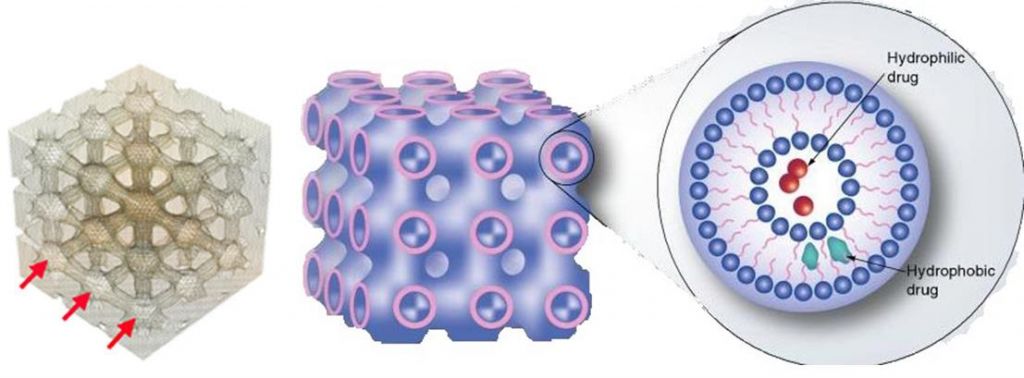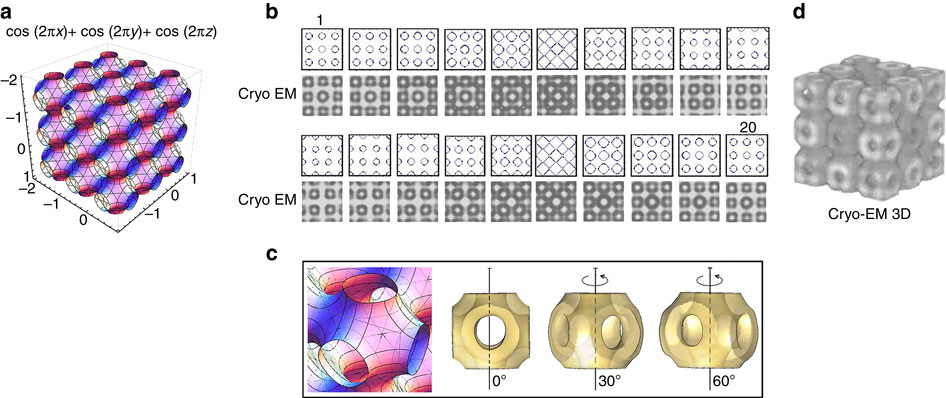A New feat in Nanomedicine: The Cubosome drug delivery system has now been 3D-mappped and studied internally by Scientists from the Swiss Federal Institute of Technology (EPFL) and University of Coimbra (Portugal) at the Nestlé Research Center in Lausanne (Switzerland).
 What are Cubosomes? These small nanostructures are ‘crystalline liquid phases’ engineered in bulk to hold drugs and deliver them to target tissue intravenously. Although also lipid based, they differ from other drug-carrier systems such as liposomes due to their cubic shape. Published in Nature Communications , the research team at EPFL used cryo-electro tomography (CET) techniques to image and 3-dimensionally map the internal structure of these cubosomes, to better understand their bio-compatability.
What are Cubosomes? These small nanostructures are ‘crystalline liquid phases’ engineered in bulk to hold drugs and deliver them to target tissue intravenously. Although also lipid based, they differ from other drug-carrier systems such as liposomes due to their cubic shape. Published in Nature Communications , the research team at EPFL used cryo-electro tomography (CET) techniques to image and 3-dimensionally map the internal structure of these cubosomes, to better understand their bio-compatability.
This technique meant embedding the cubosome structures into a glass-like sheet of ice, which is then lowered to -170°C for imaging of the structures at the Centre for Electron Microscopy (CIME) at EPFL in Lausanne. Such methods of CET imaging help give better definition to biological strucutres, such as the intracellular walls of organelles, or the particular proteins which are targeted by specific drugs. As Cécile Hébert from EPFL’s CIME explained:
Because the CET microscope distinguishes the different densities between cubosome and ice, it is very sensitive and precise“

The team found that elucidating the internal structure of the cubosomes actually altered previous mathematical models associated with their drug delivery. For example, in the case of glucose (a test molecule), it has been found that co-efficient for the binding of the carrier to the molecule was between 10-100 times lower when in a lamellar (more planar) phase compared to a ‘bi-continous’ phase (seen in cubosomes).
Since in previous studies of cubosomes the molecule transfer process was thought to be much simpler and direct (due to lack of understanding of the internal structure), these results therefore demand a re-adjustment and re-examination of the previous models for certain hydrophilic drugs being researched for cubosome delivery.

For example, recent bio-pharmaceutical applications of cubosomes include flurbiprofen (an anti-inflammatory for ophthalmology, dentistry and arthritis), diazepam (i.e. Valium) and dexamethasone (a broad range anti-inflammatory steroid).
Odorranalectin, a lectin peptide, has also been extensively researched for cubosome facilitation across the blood brain barrier, shown to enhance the therapeutic effects of Gly14-humanin on Alzheimer’s disease in rats and also in Parkinson’s. Odorranalectin is particularly hoped to served as a nose-to-brain carrier for drugs, due to it’s low immunogenicity compared to other lectins (which are generally very large molecules – and therefore irritating).
This latest research therefore calls in to question the efficacy of using cubosomes as an advanced drug delivery system of the future in Pharma. From the evidence, it is clear a revision of prior pharmaceutical research is needed before we can appreciate their true value to Nanomedicine.





